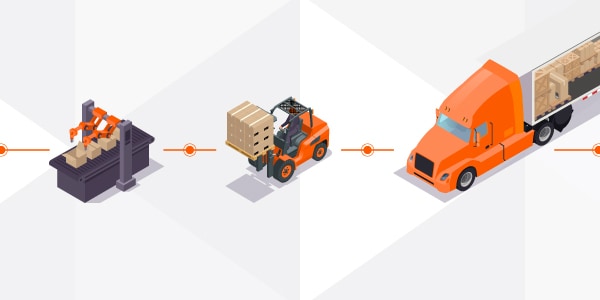
Moving freight is only half the battle when it comes to your supply chain. In order to achieve true supply chain optimization, it’s critical to gather, analyze, and act on streams of data collected throughout a product’s journey. Data from warehousing, fulfillment, shipping, and all the way to the end destination can tell you where inefficiencies in your supply chain are costing you time and money.
What should you track when it comes to your logistics data, and should it be used? Find out more in this quick snapshot of logistics data collection.
Why track your supply chain data?
Getting to the “why” behind your logistics data tracking is important because it helps you determine which key performance indicators are important to track in your supply chain. What are you trying to accomplish?
In general, the purpose of analyzing supply chain and shipping data is to:
- Providing better service to your customers
- Reducing the costs and work involved in storing and moving freight
- Eliminate inefficiencies in your supply chain
Scale your business
Data reduces guesswork
If your business does not have a substantial amount of data to work with, you are forced to make educated guesses regarding your shipping strategy. The data you gather eliminates this guesswork and replaces it with a sound, evidence-based strategy that can help your business scale.
The shipping data you collect can help you predict:
- Shipping costs and accessorial charges
- Carrier rates at different times of the year
- Lane performance
- Delays due to a variety of causes (weather patterns, storm seasons, peak seasons, etc.)
- Common causes of freight damage and claims
- Trends in fuel prices
Data helps you understand customer trends
While the supply and delivery sides of the equation are important to shipping strategy, it’s also worth looking into the end game for the supply chain: the customer. Understanding what your customers want is essential to formulating a strategy that is centered around their satisfaction and securing future sales.
Understanding where your customers are and what they are buying can lead to better LTL and partial load optimization, route and carrier selection, warehouse locations and many other decisions that will drive down the costs and transit times of items.
What data should be tracked?
Some customers trends that you should look out for based on the data you have collected are:
- Geographic locations: where are your customers located?
- Order quantities: what are they ordering and when?
- Frequency of orders: how often are they ordering? Are there peak times or patterns to discern?
- Items groupings: what items are they purchasing together?
When it comes to your supply chain, warehousing, and shipping and fulfillment operations, these are some of the key performance indicators you should focus on:
Item fill rates
Item fill rate is the ratio in which item were received compared to the order quantity. Item fill rates are important to track because they help you determine which products are being ordered as well as the quantities ordered. They can help you determine how many of each item you need to keep on hand as well as how much space should be allocated in warehouses to each item.
Orders fulfillment details
Fulfilled orders are a combination of multiple shipping KPIs:
- On-time shipments
- Correct shipping addresses
- Damage-free orders
- Correct items shipped
Together, these components make for a complete, “perfect” order. While it is important to track each of these KPIs individually, perfect orders should also be tracked at a higher level. If your percentage of perfect orders drops, you can dig deeper into each component to identify where the problem is occurring.
Operational Costs
Operational costs are the end-all costs of your supply chain. It is another high level, all-encompassing KPI that consists of:
- Manufacturing and procurement costs
- Warehousing and distribution costs
- Shipping and carrier costs
Supply chain costs should be watched closely in order to determine product prices and shipping rates. In an age where customers demand affordable shipping rates, supply chain managers need to carefully track costs to see where they can make cuts in order to make shipping more affordable for consumers.
Time metrics
There are several time-based KPIs supply chain managers can track:
- Transit times
- Pick and queue times
- Total order times
The total time that it takes for customers to receive products from the moment they are ordered in integral in an e-commerce marketplace that advertises fast shipping. Supply chain managers should monitor everything from lane performance to pick and pack times in order to eliminate redundancies and optimize performance. This allows customers to receive their items as quickly as possible.
King can help you track and analyze data
Data tracking and analysis is a large part of what we do at King Solutions. We help our customers analyze and optimize their supply chains, reducing costs and inefficiencies and helping them provide better customer service. With options like pallet level visibility and inventory management, we help you collect the data you need to perform at your best while scaling your business.
Ready to talk about a supply chain data solution that works for your business? Get in touch with our logistics experts today to go over the finer details.







 Joel Rice
Joel Rice